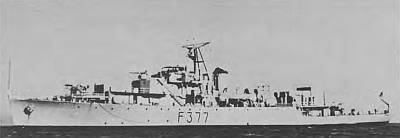- Author
- Ware, John
- Subjects
- None noted
- Tags
-
- RAN Ships
- None noted.
- Publication
- August 1972 edition of the Naval Historical Review (all rights reserved)
Diamantina, Countess Roma, his wife, who died in 1893 (at Malta) accompanied Bowen to Australia in 1859. She was a member of the Riccardi branch of the Italian-Canadian family and it was to honour her that the name of Mueller River bestowed by McKinlay was rejected in favour of Diamantina. She is also commemorated in the name of the south-east Queensland town of Roma. It is the arms and motto of the Riccardi-Canadian family that have been adopted as the ship’s badge and motto of HMAS Diamantina. The motto Hic Regit Ille Tuetor has been translated as ‘Whoever Rules Protects’.

Diamantina commissioned under the command of Lieutenant-Commander M.G. Rose, RANVR, on 27th April 1945 at Hervey Bay, Queensland, proceeding on the same day for Sydney where she remained until 24th May. In June, she completed her trials before proceeding to New Guinea, arriving Madang from Cairns on 23rd June and thence to Torokina (Solomons) to await the arrival of the Governor-General, HRH Duke of Gloucester, to provide transport to Saposa Island. This assignment was subsequently cancelled, but on 5th July Diamantina proceeded to Saposa with Lieutenant- Generals Sturdee and Savige and several of their staff officers embarked.
On 7th July, Diamantina carried out a bombardment of Sohana Island before leaving Saposa to return to Torokina.
Leaving Torokina on 17th July, Diamantina returned to the Saposa area and on 18th July took up a firing position off the east coast of Taiof Island for a second bombardment of Japanese batteries located on Sohana Island. A few minutes after the scheduled firing was completed, one Japanese heavy gun opened fire and a few shots fell harmlessly 400 yards astern.
The following day, Diamantina again provided supporting fire for the Australian troops ashore in Bougainville before proceeding to Manus where she arrived on 21st July to begin boiler cleaning.
On 7th August Diamantina returned to Torokina and the following day resumed bombardment of Japanese positions in the Solomons, shelling the Bonis Peninsular and points along the south side of Buka Passage. On completion of what proved to be her last operational bombardment of the war she proceeded to Choiseul Bay and thence to Lae, Langemak and on VJ Day (15th August) Madang.
In September. Diamantina returned to the Solomons and on 8th September embarked Lieutenant-General Kanda and Vice-Admiral Samejima and their staffs for passage to Torokina for the official surrender of Japanese forces in the Solomons.
On the same day (8th September), Diamantina sailed for Nauru Island as Senior Naval Officer of the Nauru-Ocean Island Occupation Force. Following the official surrender of Nauru on board Diamantina she returned to Torokina on 19th September, departing on 22nd September for surrender of Ocean Island. En route on 26th September, she called at Tarawa where she was welcomed as the first British warship to the Gilbert Islands since prewar days. On 30th September, she arrived at Ocean Island for the surrender and occupation.
On 10th October Diamantina returned to New Guinea (Madang) where she remained for eighteen days before proceeding to Rabaul. In November, she was engaged towing an LCM, salvaging stores abandoned on Emirau Island (Admiralties) and transporting a mine disposal party along the east coast of New Hanover.
On 22nd November Lieutenant- Commander P.J. Sullivan, RANR, assumed command from Lieutenant-Commander M.G. Rose, RANVR.
In December, after transporting troops of the Australian 6th Division from Wewak to Madang, Diamantina sailed for Sydney carrying 78 passengers. Sydney Harbour was reached on 13th December, after an absence of 181 days. Since commissioning the ship had steamed 17,625 miles and had been under way 1,161 hours.
In March 1946, Diamantina returned to New Guinea and for the next two months was engaged on general duties based on Rabaul and Manus. On 31st May she departed Manus beginning a fourteen day tow of ASR 912 to Sydney via Trobriand Islands, Milne Bay, China Straits, Port Moresby, Bramble Bay and thence inside the Barrier Reef.
On 25th June 1946, Diamantina entered Port Phillip for the first time when she arrived at Williamstown. She paid off into reserve on 9th August 1946. Since commissioning she had steamed 29,175 miles.




